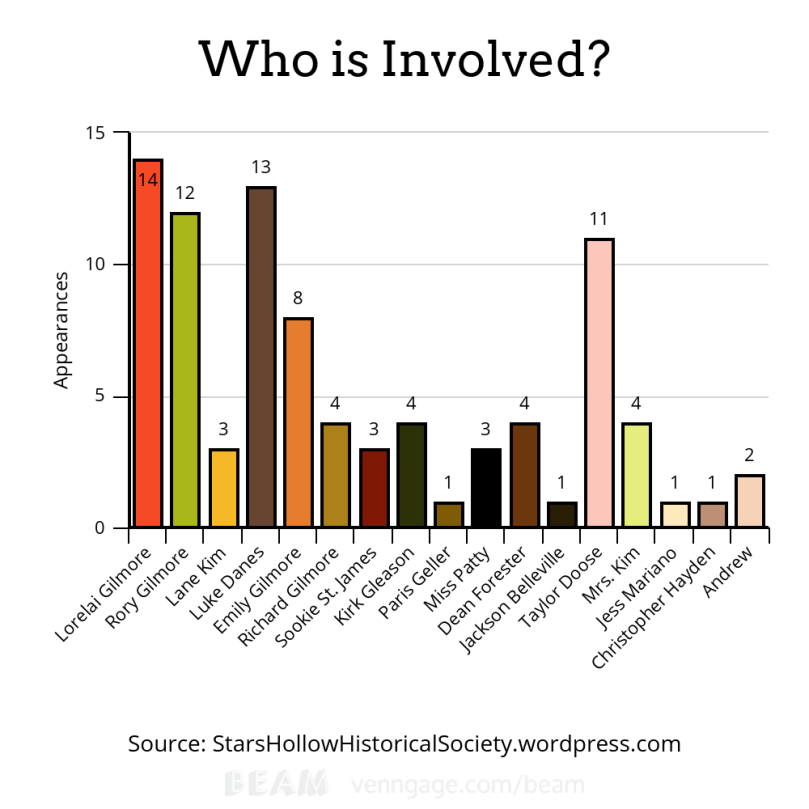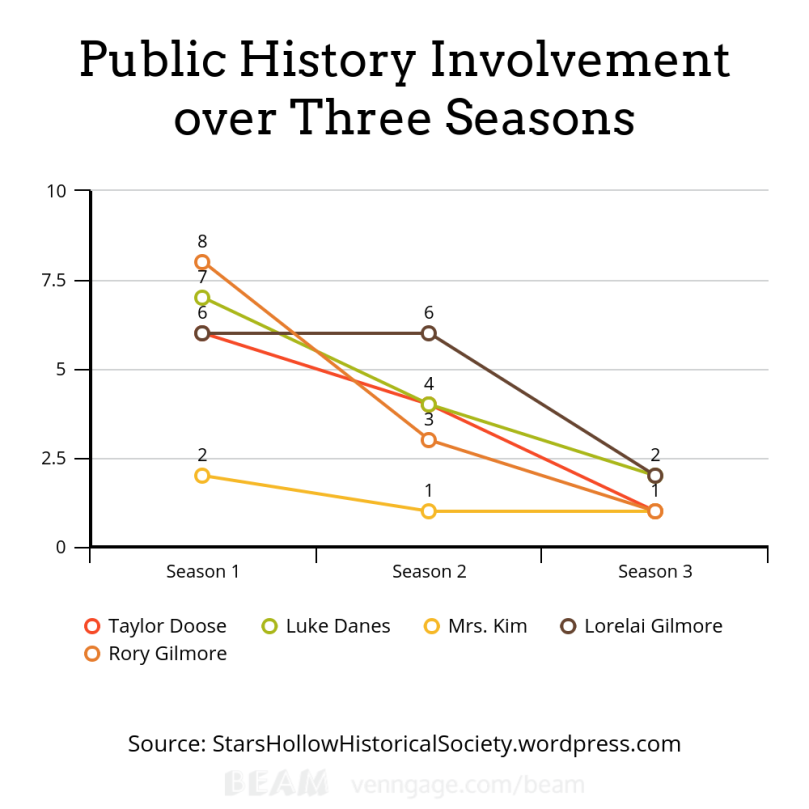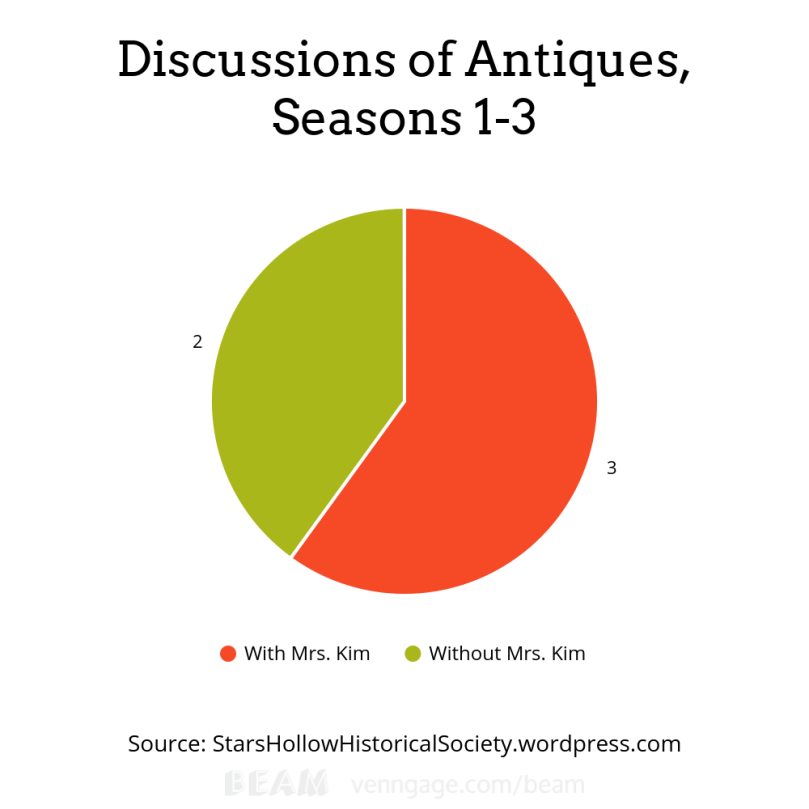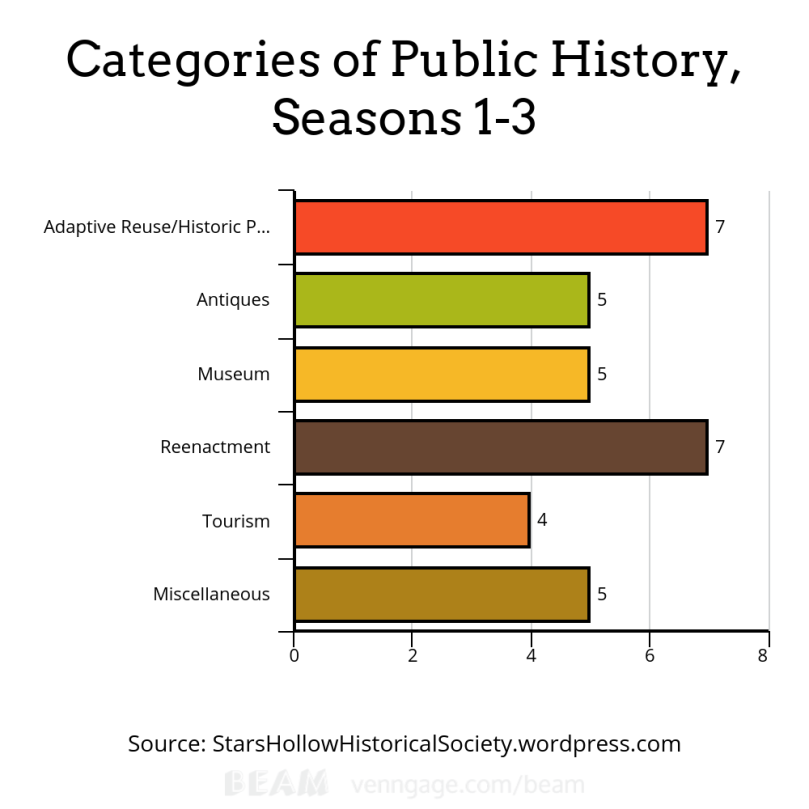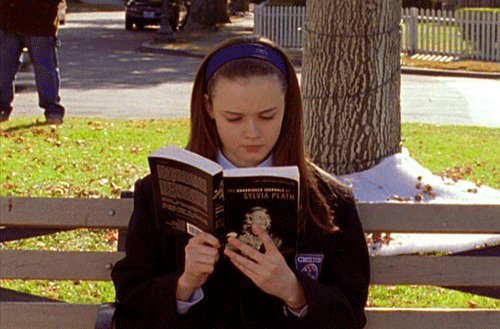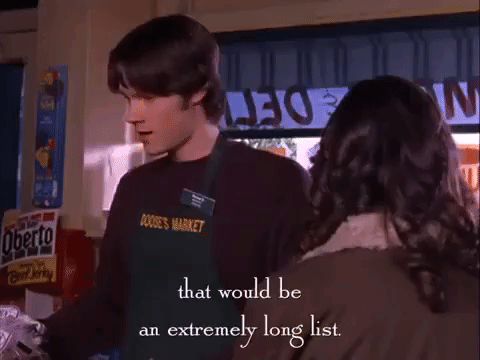This post comes to the Stars Hollow Historical Society from Emily Esten, an MA Candidate in Public Humanities at Brown University. For more about Emily’s work, check out her website https://emilyesten.com and follow her on twitter @sheishistoric.
Everyone’s favorite close-knit community, Stars Hollow, Connecticut, thrives on small-town charm, tourism, and commemorating local history. The show presents two narratives of the town’s founding throughout the show’s seven-season run: 1) the star-crossed lovers meeting in the location of the town’s gazebo; and 2) the story of a Puritan family arriving in the seventeenth century. Regardless of their portrayals as true stories or imagined pasts, both narratives, which capitalize on myth and nostalgia to create a compelling story. From a public history perspective, the show’s depiction and commentary on Stars Hollow’s founding plays directly into concepts of nostalgia, memory, and commemoration in communities.
The first of these founding myths, the star-crossed lovers, appears twice onscreen through one of the many celebratory festivals celebrated in Stars Hollow, Connecticut. Featured in episodes S1E16 “Star-Crossed Lovers and Other Strangers” and S4E13 “Nag Hammadi Is Where They Found the Gnostic Gospels,” the Firelight Festival commemorates the town’s founding and namesake. Described by Miss Patty, the story states that star-crossed lovers snuck out of their homes and followed a band of stars to a spot in the countryside. “And there,” says Miss Patty, “waiting for her was her one true love who had also been led here by the blanket of friendly stars. And that, my friends is how Stars Hollow came to be and why we celebrate that fateful night every year about this time.” According to the story, the town commemorated the lovers’ meeting-place with the famous Stars Hollow Gazebo.

Outside of the festival’s significance to the game-changing storylines of Lorelai and Rory in both episodes, the myth lends itself to the storybook-charm of the Stars Hollow community. As Lorelai remarks in S1E16, this piece of lore and the corresponding festival create a sense of love in the air for the community. The trope of star-crossed lovers, common to literature and film, emphasizes emotion over rationality, destiny over free will. The key values promoted in the myth of star-crossed lovers play directly into the town’s portrayal in Gilmore Girls. Known for bonding together during regular celebrations of happiness, its heavy-handed involvement in the relationships of the Gilmore women, and constant pressure for total community involvement, the Stars Hollow community too emphasizes emotion over rationale in a love-conquers-all fashion. Reflecting Glassberg’s discussion of public history as political culture, Stars Hollow uses this myth to shape the community’s relationship to the town – that no matter what barriers present themselves, the community can bond together and envision themselves as members of this collective present and future. This myth, perpetuated through the annual festival celebration, shapes the town’s present-day activities and community participation.
In the same episode, characters also argue the particulars of the myth in regard to a bonfire held during the festival:
TAYLOR: No, no, Patty, you’re wrong. They built the fire to throw themselves on it when their families found them.
PATTY: Taylor, you’re crazy! They built the fire so that they could stay warm their first night here.
TAYLOR: Patty, I am the recording secretary for the Stars Hollow City Council, I think I know how my town was founded!
While the characters fail to come to a conclusion on the origins of the bonfire, this incident also showcases James Young’s idea of “collected memory” in action. Taylor Doose’s perspective places the star-crossed lovers’ story ending in tragedy; while Patty’s ending foreshadows possible hope or enduring love for the couple. In addition, Taylor attempts to use his political position as a form of expertise to triumph his ending for the myth. Both characters express personal stakes in the myth – Patty’s ending more romantic and nostalgic supports her role as a town matchmaker, Taylor’s ending gives the myth a more tragic twist to further the trope. In his attempts to debunk Patty’s ending, Taylor hopes to connect the history of Stars Hollow to literary romantic fiction like that of Verona’s Juliet. This negotiation over the festival’s importance brings the myth of the star-crossed lovers directly into public space through the presence of the festival bonfire.
And not all the town’s citizens claim the Firelight Festival as the true story of Stars Hollow. As Luke Danes later remarks, “It’s a crazy festival based on a nutty myth about two lunatics, who in all probability did not even exist. And even if they did, probably dropped dead of diphtheria before age 24.” He goes on to suggest that the town’s name perhaps has an unseemly history of prostitution, and that the name “Stars Hollow” has its roots of bring.

In the moment, Luke’s frustration with the star-crossed lovers and the Firelight Festival comes from his own forlorn relationship experiences. Debunking the myth for Luke is self-serving – it would justify his own feelings around love. The presence of the myth in his day-to-day experiences and especially with the Firelight Festival creates an internal dissonance with which he struggles.
Though other characters criticize Luke’s cynicism, his complaint has historical merit. Including Luke in the larger conversation around local history and myth, the show both pokes fun at the mythical founding and its corresponding sentiment. But Luke also raises a more important question: what place does myth have in commemoration? To answer that question, one must review the act of commemoration in both episodes: the festival. Regardless of the celebration’s historical accuracy, the festival’s significance to town citizens transcends the myth upon which it is based. Sense of place is integral to understanding the Stars Hollow community – the emotional connections developed through the integrated social networks and places in the town. As Mayor Harry Porter presides over the festival in season one, he remarks that he met his own “true love, Miss Dora Braythwait” at the gazebo where the festival takes place.

Tying his marriage to the myth of the star-crossed lovers, Mayor Porter ties public history/myth to his own personal identity. Over the course of the series, the physical commemoration of the gazebo creates a similar connection for many lovers and relationships of Stars Hollow – a place for engagements, first kisses, weddings, and declarations of love. With the gazebo’s connection founding myth of star-crossed lovers, the material culture commemoration of the spot places the myth center-stage as way to create a memory site of both cultural and communal value. Combined with the festival, the public commemoration activities within Stars Hollow make the myth accessible to its public.
However, for some citizens, the myth has lost all value in commemoration. In S4E13, Kirk Gleason takes over planning the festival. Hijinks ensue. Doing his best to respect the ritual and tradition of the ceremony, Kirk isn’t motivated by accurate representation of the star-crossed lovers’ story. Instead, his loyalty is to the town – to Taylor, who has stepped away for this year’s proceedings, and to prove his worth as an individual with such a major contribution.
For Kirk, the memory being commemorated is irrelevant; the ritualized commercialization of the event – down to the flaming batons and star-shaped hotdogs – becomes crucial. In its celebration of the town and its present community as well as commemoration of its mythic founding, the Firelight Festival shows how the myth and memory can, over time, contribute to the event gaining its own value and presence as a part of local history. G



